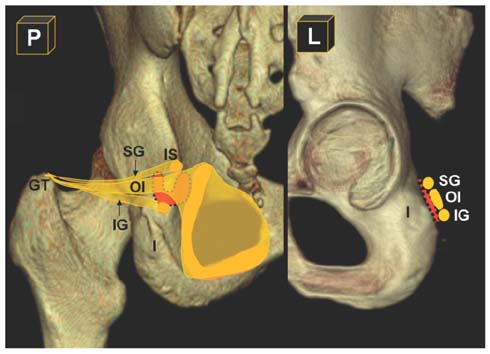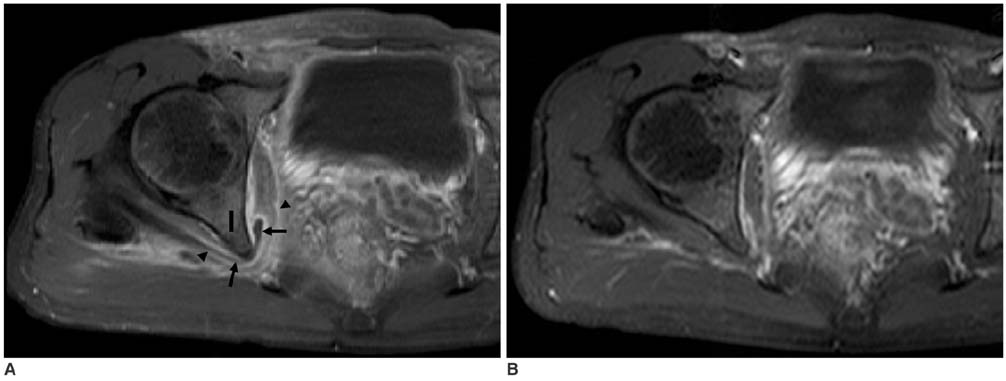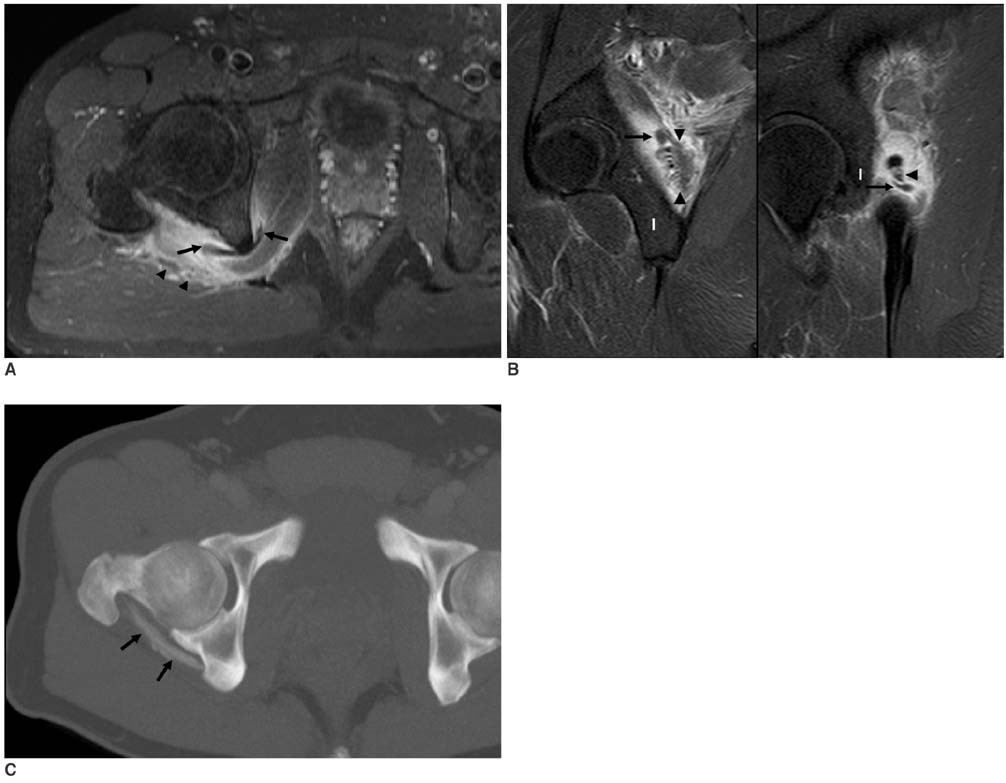Korean J Radiol.
2008 Aug;9(4):375-378. 10.3348/kjr.2008.9.4.375.
MR Imaging Features of Obturator Internus Bursa of the Hip
- Affiliations
-
- 1Department of Radiology and Medical Research Institute, School of Medicine, Ewha Womans University, Seoul, Korea. mshjy@ewha.ac.kr
- 2Department of Orthopedic Surgery and Medical Research Institute, School of Medicine, Ewha Womans University, Seoul, Korea.
- KMID: 1076465
- DOI: http://doi.org/10.3348/kjr.2008.9.4.375
Abstract
- The authors report two cases with distension of the obturator internus bursa identified on MR images, and describe the location and characteristic features of obturator internus bursitis; the "boomerang"-shaped fluid distension between the obturator internus tendon and the posterior grooved surface of the ischium.
Keyword
Figure
Reference
-
1. Williams A, Newell RL. Standring S, editor. Pelvic girdle, gluteal region and hip joint. Gray's Anatomy. 2005. 39th ed. Philadelphia: Elsevier;1447–1448.2. Wunderbaldinger P, Bremer C, Schellenberger E, Cejna M, Turetschek K, Kainberger F. Imaging features of iliopsoas bursitis. Eur Radiol. 2002. 12:409–415.3. Dunn T, Heller CA, McCarthy SW, Dos Remedios C. Anatomical study of the "trochanteric bursa". Clin Anat. 2003. 16:233–240.4. Pfirrmann CW, Chung CB, Theumann NH, Trudell DJ, Resnick D. Greater trochanter of the hip: attachment of the abductor mechanism and a complex of three bursae-MR imaging and MR bursography in cadavers and MR imaging in asymptomatic volunteers. Radiology. 2001. 221:469–477.5. Cho KH, Lee SM, Lee YH, Suh KJ, Kim SM, Shin MJ, et al. Non-infectious ischiogluteal bursitis: MRI findings. Korean J Radiol. 2004. 5:280–286.6. Robinson P, White LM, Agur A, Wunder J, Bell RS. Obturator externus bursa: anatomic origin and MR imaging features of pathologic involvement. Radiology. 2003. 228:230–234.7. Shinohara H. Gemelli and obturator internus muscles: different heads of one muscle? Anat Rec. 1995. 243:145–150.8. Swezey RL. Obturator internus bursitis: a common factor in low back pain. Orthopedics. 1993. 16:783–785.9. Viani RM, Bromberg K, Bradley JS. Obturator internus muscle abscess in children: report of seven cases and review. Clin Infect Dis. 1999. 28:117–122.10. Rohde RS, Ziran BH. Obturator internus tendinitis as a source of chronic hip pain. Orthopedics. 2003. 26:425–426.
- Full Text Links
- Actions
-
Cited
- CITED
-
- Close
- Share
- Similar articles
-
- Obturator Externus Bursitis: Cases report
- Obturator Internus Pyomyositis: A Case Report
- Obturator Neuropathy after Traumatic Posterior Hip Dislocation: A case report
- Rapid Destruction of the Hip Joint Accompanied by an Enlarged Iliopsoas Bursa in a Healthy Man
- Obturator Internus Myofascial Pain: A Cause of Undiagnosed Chronic Pelvic Pain Syndrome: Case reports




